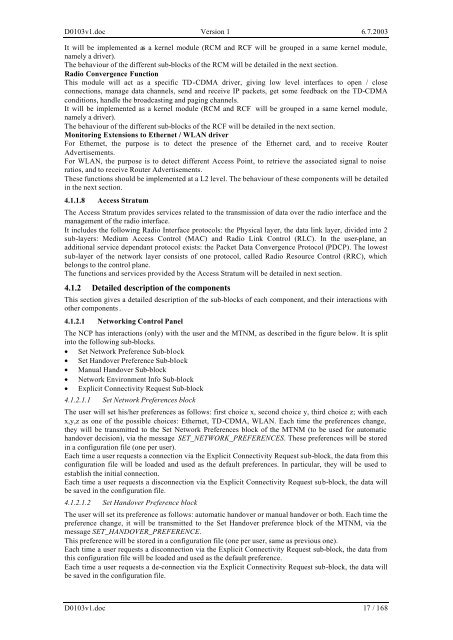Moby Dick Consolidated System Integration Plan
Moby Dick Consolidated System Integration Plan
Moby Dick Consolidated System Integration Plan
You also want an ePaper? Increase the reach of your titles
YUMPU automatically turns print PDFs into web optimized ePapers that Google loves.
D0103v1.doc Version 1 6.7.2003<br />
It will be implemented as a kernel module (RCM and RCF will be grouped in a same kernel module,<br />
namely a driver).<br />
The behaviour of the different sub-blocks of the RCM will be detailed in the next section.<br />
Radio Convergence Function<br />
This module will act as a specific TD-CDMA driver, giving low level interfaces to open / close<br />
connections, manage data channels, send and receive IP packets, get some feedback on the TD-CDMA<br />
conditions, handle the broadcasting and paging channels.<br />
It will be implemented as a kernel module (RCM and RCF will be grouped in a same kernel module,<br />
namely a driver).<br />
The behaviour of the different sub-blocks of the RCF will be detailed in the next section.<br />
Monitoring Extensions to Ethernet / WLAN driver<br />
For Ethernet, the purpose is to detect the presence of the Ethernet card, and to receive Router<br />
Advertisements.<br />
For WLAN, the purpose is to detect different Access Point, to retrieve the associated signal to noise<br />
ratios, and to receive Router Advertisements.<br />
These functions should be implemented at a L2 level. The behaviour of these components will be detailed<br />
in the next section.<br />
4.1.1.8 Access Stratum<br />
The Access Stratum provides services related to the transmission of data over the radio interface and the<br />
management of the radio interface.<br />
It includes the following Radio Interface protocols: the Physical layer, the data link layer, divided into 2<br />
sub-layers: Medium Access Control (MAC) and Radio Link Control (RLC). In the user-plane, an<br />
additional service dependant protocol exists: the Packet Data Convergence Protocol (PDCP). The lowest<br />
sub-layer of the network layer consists of one protocol, called Radio Resource Control (RRC), which<br />
belongs to the control plane.<br />
The functions and services provided by the Access Stratum will be detailed in next section.<br />
4.1.2 Detailed description of the components<br />
This section gives a detailed description of the sub-blocks of each component, and their interactions with<br />
other components .<br />
4.1.2.1 Networking Control Panel<br />
The NCP has interactions (only) with the user and the MTNM, as described in the figure below. It is split<br />
into the following sub-blocks.<br />
• Set Network Preference Sub-block<br />
• Set Handover Preference Sub-block<br />
• Manual Handover Sub-block<br />
• Network Environment Info Sub-block<br />
• Explicit Connectivity Request Sub-block<br />
4.1.2.1.1 Set Network Preferences block<br />
The user will set his/her preferences as follows: first choice x, second choice y, third choice z; with each<br />
x,y,z as one of the possible choices: Ethernet, TD-CDMA, WLAN. Each time the preferences change,<br />
they will be transmitted to the Set Network Preferences block of the MTNM (to be used for automatic<br />
handover decision), via the message SET_NETWORK_PREFERENCES. These preferences will be stored<br />
in a configuration file (one per user).<br />
Each time a user requests a connection via the Explicit Connectivity Request sub-block, the data from this<br />
configuration file will be loaded and used as the default preferences. In particular, they will be used to<br />
establish the initial connection.<br />
Each time a user requests a disconnection via the Explicit Connectivity Request sub-block, the data will<br />
be saved in the configuration file.<br />
4.1.2.1.2 Set Handover Preference block<br />
The user will set its preference as follows: automatic handover or manual handover or both. Each time the<br />
preference change, it will be transmitted to the Set Handover preference block of the MTNM, via the<br />
message SET_HANDOVER_PREFERENCE.<br />
This preference will be stored in a configuration file (one per user, same as previous one).<br />
Each time a user requests a disconnection via the Explicit Connectivity Request sub-block, the data from<br />
this configuration file will be loaded and used as the default preference.<br />
Each time a user requests a de-connection via the Explicit Connectivity Request sub-block, the data will<br />
be saved in the configuration file.<br />
D0103v1.doc 17 / 168
















